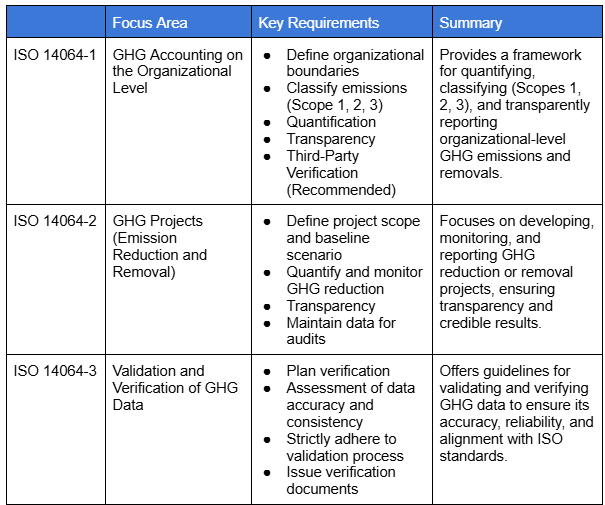- Article Summary
-
In today’s rapidly evolving business landscape, sustainability and environmental responsibility have become paramount. One of the key frameworks aiding organizations in this endeavor is the ISO 14064 standard. This international standard provides a structured approach to measuring, reporting, and verifying greenhouse gas (GHG) emissions. But what exactly does ISO 14064 entail, and how can it benefit your business? Let’s delve deeper.
What is ISO 14064?
ISO 14064 is part of the ISO 14000 family of standards, which focuses on environmental management systems. Specifically, ISO 14064 offers tools for organizations to quantify, monitor, report, and verify their GHG emissions. This standard is divided into three parts:
- ISO 14064-1: Provides specifications and guidance at the organizational level for the quantification (Scope 1, 2, 3) and reporting of GHG emissions and removals.
- ISO 14064-2: Focuses on GHG projects, such as renewable energy installations, detailing principles and requirements for determining baselines and monitoring, quantifying, and reporting project performance.
- ISO 14064-3: Offers guidelines for validating and verifying GHG assertions, ensuring the credibility and reliability of GHG reports.
Objectives of ISO 14064
The primary goals of ISO 14064 include:
- Enhancing Environmental Integrity: By providing a consistent and transparent approach to GHG accounting, ISO 14064 helps organizations improve the accuracy and credibility of their emissions data.
- Facilitating Trade and Market Mechanisms: Standardized GHG reporting enables participation in emissions trading schemes and other market-based mechanisms aimed at reducing global emissions.
- Supporting Regulatory Compliance: As governments worldwide implement stricter environmental regulations, ISO 14064 assists organizations in meeting these requirements efficiently.
Key Requirements of ISO 14064
To align with ISO 14064, organizations should:
- Develop a GHG Inventory: Identify and quantify all relevant GHG emissions and removals associated with the organization’s operations.
- Implement GHG Management Strategies: Establish procedures for regular monitoring, reporting, and verification of GHG data.
- Ensure Transparency: Maintain clear documentation and provide accessible information to stakeholders regarding GHG emissions and reduction efforts.
14064-1: Requirements for Reporting GHG Emissions and Removal at the Organizational Level
- Organizational and Operational Boundaries: Define the GHG inventory from all pertinent sources of emissions and carbon absorption points, thus setting the organizational boundary. For example, this could follow the equity share approach or control approach (financial or operational control). Operational boundaries pertain to identifying emissions as Scope 1 (direct emissions), 2 (indirect emissions), or 3 (other indirect emissions such as supply chain).
- Quantification of GHG Emissions and Removals: Identify all significant sources of GHG emissions and removals relevant to the organization. Furthermore, use scientifically sound and consistent methods for calculating emissions and removals, such as activity data and emission factors. Base year must be selected to be able to compare future performances with to measure changes.
- GHG Reporting: The following must be clearly stated in the report: Reporting Period, Data Sources, Calculation Methods, Assumptions and Limitations. Reporting period refers to the time frame of the report. The origin of the data and how emissions are quantified must be shown in the report. If there are any uncertainties or constraints in the data, it must be made clear too.
- Data Verification: Third-party verification is recommended (though not mandatory) to ensure accuracy and build credibility.
14064-2: Requirements for GHG Projects
- Project Definition: Clearly define the project’s boundaries, objectives, and intended outcomes for GHG reductions or removals.Furthermore, Ensure the project meets criteria for additionality (i.e., emission reductions go beyond business-as-usual scenarios).
- Baseline Scenario: Define a baseline scenario to represent what emissions levels would be without the project intervention. Show that the project achieves emissions reductions that wouldn’t occur under the baseline scenario.
- Quantification and Monitoring: Use recognized methods to calculate GHG reductions or removals (e.g., emission factors and modeling tools). For a monitoring plan implement a plan to track project performance over time and collect data for quantifying GHG reductions.
- Transparency and Reporting: Disclose information on data sources and methodologies used for calculations and assumptions, limitations, and uncertainties affecting the results. Additionally, share project results in a clear and consistent format.
- Data Management and Retention: Keep detailed records of data used to quantify GHG reductions and monitoring activities and methodologies. Ensure records are sufficient to support future audits and verification processes.
- Optional Verification: Although verification is not mandatory under ISO 14064-2, organizations are encouraged to have their projects independently validated or verified to ensure credibility.
14064-3: Requirements for GHG Valuation and Verification
- Verification Planning: Clearly define the data or GHG claims being verified. Include the level of assurance provided. Reasonable assurance means a high level of scrutiny and confidence in the data. Limited assurance means a lower level of scrutiny, offering moderate confidence in the data. There is also a need to establish objectives and specific criteria to assess the GHG data against ISO principles.
- Data Assessment: Confirm accuracy, completeness, and consistency of the reported data. Check for any errors, misstatements, or inconsistencies. Ensure that the GHG data aligns with ISO 14064 standards and organizational methodologies and boundaries (if applicable). Furthermore, identify risks of material misstatement in the reported data.
- Validation and Verification Process: Evaluate the methods and processes used for quantifying GHG emissions or reductions. Whenever possible, compare reported data with supporting evidence and independent sources, and ensure proper communication with the organization being audited.
- Validation Statements: Upon completion, issue a verification statement summarizing the findings, including:
- Scope and level of assurance provided.
- Conformance with ISO 14064 requirements.
- Any limitations, assumptions, or uncertainties identified.

Benefits of Implementing ISO 14064
Adopting ISO 14064 can offer several advantages:
- Improved Credibility: Third-party verification of GHG data enhances stakeholder trust and can strengthen brand reputation.
- Operational Efficiency: Identifying emission sources can lead to more efficient resource utilization and cost savings.
- Market Opportunities: Participation in carbon markets and access to environmentally conscious investors become more feasible.
Preparing for ISO 14064 Implementation
To effectively implement ISO 14064, organizations should:
- Conduct a Gap Analysis: Assess current GHG management practices against ISO 14064 requirements to identify areas needing improvement.
- Train Personnel: Ensure that staff members understand GHG accounting principles and the importance of accurate data collection.
- Engage Stakeholders: Communicate the organization’s commitment to GHG management and involve stakeholders in the process.

Why Choose Asuene USA Inc. for ISO 14064 Compliance?
When it comes to aligning your business with ISO 14064 standards, having the right tools and expertise is essential. Asuene USA Inc., the U.S. entity of sustainability-focused Asuene Inc. from Japan, specializes in helping businesses effectively measure, manage, and mitigate their greenhouse gas (GHG) emissions. Here’s how Asuene USA Inc. can support your ISO 14064 journey:
Comprehensive Carbon Accounting
- Accurate GHG Measurement: With advanced carbon accounting software, Asuene USA enables businesses to track Scope 1, Scope 2, and Scope 3 emissions in line with ISO 14064 requirements.
- Data Automation: Simplify the process of data collection with automated tools that reduce the time and resources spent on manual entries.
- Customizable Reports: Generate ISO-compliant GHG reports tailored to your organization’s operations and stakeholder needs.
Third-Party Verification
- Reliable Validation: Ensure the credibility of your GHG data with independent third-party verifications offered by Asuene USA.
- ISO 14064 Alignment: The verification process is designed to meet the specific validation and verification requirements outlined in ISO 14064-3.
Sustainability Consulting
- Tailored Strategies: Receive expert advice on developing and implementing GHG management systems that align with ISO 14064 objectives.
- Performance Optimization: Identify emission hotspots and adopt strategies to improve operational efficiency and reduce environmental impact.
- Regulatory Navigation: Stay ahead of global sustainability regulations with guidance on ISO 14064 integration into broader compliance frameworks.
Training and Capacity Building
- Employee Education: Equip your team with the knowledge and skills to maintain ISO 14064 standards, ensuring ongoing compliance and continuous improvement.
- Stakeholder Engagement: Support communication strategies to demonstrate your commitment to sustainability and transparency.
Why Partner with Asuene USA Inc.?
- End-to-End Solutions: From GHG inventory creation to third-party verification and reporting, Asuene USA offers a one-stop solution for ISO 14064 compliance.
- Proven Expertise: Leverage years of experience in carbon accounting and sustainability consulting backed by Asuene’s innovative technology.
- Global and Local Support: With a strong understanding of international standards and regional regulations, Asuene USA ensures your business is well-prepared for global market participation.
Drive Sustainability with Confidence
ISO 14064 compliance is not just about meeting standards—it’s about embracing a culture of environmental responsibility that positions your business as a leader in sustainability. With Asuene USA Inc., you can streamline your compliance journey, reduce your environmental footprint, and showcase your commitment to a greener future.
Ready to take the next step? Let Asuene USA Inc. help you align with ISO 14064 and unlock new opportunities in sustainable business practices.

